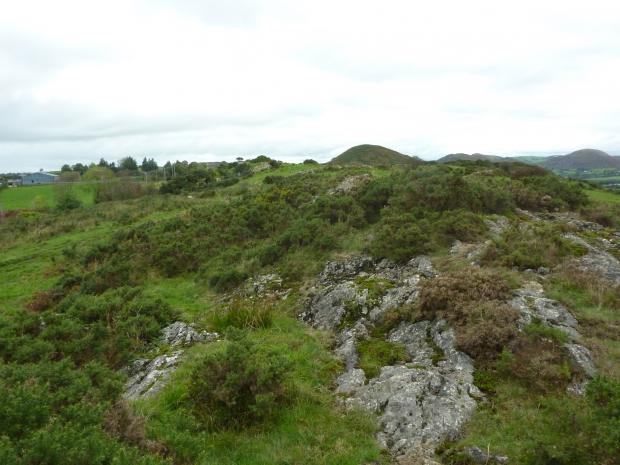
The Ring of Gullion is one of the finest examples of a ring dyke in the British Isles. It is of Palaeogene age, some 56-58 Ma. The volcanic rocks found here are of international geological importance, having played an important role in the development of a number of theories of the development and interaction between igneous rocks. The rocks found at Mullaghbane show flow banding in the ring dyke, vent agglomerate, fluid alteration and minor intrusion into the ring dyke.
The area is of special scientific interest because of its geology, which is expressed in outcrop at several discrete localities.
The Slieve Gullion volcanic complex, of which Mullaghbane is a part, is the finest example of a Tertiary igneous centre in Ireland and is among the best topographic expression of a ring-dyke system in the British Isles. The rocks found here are of international geological importance, having played an important role in a number of theories related to the development of and interaction between igneous rocks.
The Slieve Gullion complex is historically important as it has featured in a number of major geological debates on the nature of igneous rocks and the processes by which they can be formed.
Mullaghbane consist of several localities which expose a range of rock types found in the Ring of Gullion. The northernmost locality exposes the earliest rocks intruded into the ring. This vent agglomerate provides evidence of the explosive violence of the initial phase of development of the ring dyke, probably associated with degassing. Further outcrops show the contact between the felsite and the porphyritic granophyre of the main intrusion. The locality demonstrates that the granophyre was later because there is clear evidence that it chilled against the felsite with the former rock type also veining the latter.
This section of the site is important because it establishes the age relationships between the two main rock types intruded into the ring and also the relationship with the vent agglomerates.
At the central locality the Newry granodiorite, the host rock into which the ring was intruded, is here inside the ring dyke. The rock is red in colour and much altered by gases or fluids or both, moving through the rock during the period of Slieve Gullion’s earliest eruptions. Further sections show porphyritic felsite, the initial rock injected into the ring, which exhibits flow bands of welded volcanic dust, a further indication of the violent nature of this phase of the areas volcanic history.
At the southernmost locality, there is a small, vertical, cylindrical plug of dolerite enclosed in Newry granodiorite. The age of this intrusion is a matter of debate. The dolerite is seamed with granitic veins that have been attributed to the Newry granodiorite, which would make it around 390 million years old. A reinterpretation gives an alternative explanation and a Palaeogene age of around 58 million years.
Taken together these locations provide a fuller understanding of the geological history of the Slieve Gullion Ring complex.
Related articles
- ASSI Guidance for Public Bodies/Competent Authorities
- Coastal Areas of Special Scientific Interest
- Conservation Management Plans (CMPs)
- European Marine Sites - Marine Special Areas of Conservation and Special Protection Areas
- Introduction to Conservation Management Plans (CMPs) for Northern Ireland’s Special Areas of Conservation
- Marine Conservation Zones
- Marine Protected Areas
- Marine Ramsar sites
- Portrush Coastal Zone
- Special Areas of Conservation
- Special Areas of Conservation for Harbour porpoise
- Special Protection Areas
